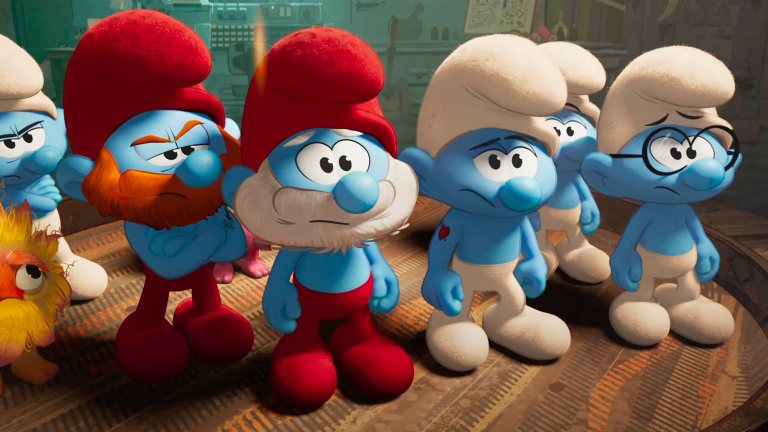The Strange History of Smurfs Movies and How These Blue Bastards Keep Coming Back
We unpack how a 1950s Belgian comic strip has turned into the most flexible and elastic of Hollywood franchises in the 21st century.

If you’ve been to the theaters recently and passed a standee for the upcoming Smurfs movie, chances are, you have audibly asked, “Those little blue bastards are back? AGAIN!? WHY?!” Lord knows I have. Somehow out of all the family-friendly intellectual property (IP) in existence, Hollywood keeps resurrecting comic artist Peyo’s uber-popular creations—the Minions to Johan and Peewit’s Gru—to infiltrate theaters. We now have as many reboots of the Smurfs as we’ve had Spider-Mans, Batmans, and Supermans in this century.
What is it about those Belgian-based blue creatures that keeps causing them to return in different forms with the near regularity of a holiday Krampus? What’s the root of their longevity? Well, believe it or not, the Smurfs have been among the most flexible in franchise entertainment when it comes to following Hollywood trends and keeping their appeal wide in every decade. Thus they are the ideal franchise for studios to earn a quick buck with. In light of the two Sony Animation iterations and the forthcoming Paramount film, it is worth reflecting on the reasons why the Smurfs keep La la la-la la la-ding their way back into the zeitgeist.
The Smurfs (2011) & The Smurfs 2 (2013): Joining the IP Bandwagon
Hollywood live-action fare has been a never-ending cycle in the 21st century of regurgitating projects from a prior generation’s youth and then repackaging them for the next. In the late 1990s to early 2010s, every animated cartoon from Gen-X’s childhoods was turned into a big live-action family movie: The Flintstones, Scooby-Doo, Yogi Bear, Garfield, Underdog, George of the Jungle, Fat Albert. You name it, and most likely there was a movie for it.
These flicks always go in two directions: either realizing these characters in a preexisting contemporary setting (Scooby-Doo, Yogi Bear, George of the Jungle) or as cartoons/nightmarish creatures that come into our world and cause mayhem (Fat Albert, Rocky and Bullwinkle). And on rare occasions, there are the incredibly intelligent satires with an anticapitalist core (Speed Racer, Josie and the Pussycats).
Nevertheless, Transformers and Alvin and the Chipmunks, which were released in 2007, were the true box office juggernauts of this cycle. Something these two movies also notably feature, respectively, are egregious product placements and hyperrealistic character designs that were still appealing and expressive while hipping them out to fit into modern culture.
The Smurfs (2011) is a Frankenstein of those two films, embodying the most cynical, consumerist aspects of the live-action adaptations that people despised, but now in a short blue package that was baked to marketing perfection. This starts with the voice cast that is so of its moment, you can still hear the 2010 timestamp being punched from the meeting where an exec said, “Katy Perry is at the pinnacle of her career, so let’s cast her as Smurfette! We also need some network stars for the parents. Let’s bring in Neil Patrick Harris, Jayma Mays, Sofia Vergara, and Hank Azaria.”
The movie incorporates so many corporate-pleasing trends in the final product that it’s hard to even call it a movie. Moreover Smurfs‘ color-coded, universal brand appeal made it the ideal conduit for spewing product placement. There was literally a Harper’s Bazaar issue with Smurfette modeling Marc Jacobs. Whereas the sequel is more plot-oriented, but otherwise still bad, the first Smurfs is a soulless paean to consumerism.
To paraphrase Rick from Rick & Morty, the globe “didn’t ask questions or raise ethical complaints, we just looked straight into the bleeding jaws of capitalism and said ‘yes daddy, please.” It grossed over nearly half a billion dollars. It was the perfect exploitative IP adaptation, arriving at the right moment at the right time.
Smurfs: The Lost Village (2017) – Frozen and the Rise of Animated Fourth-Wave Feminism
Within the same year, The Smurfs 2 dropped, a little Disney movie called Frozen was released, and it went on to gross the full billion dollars. Cool. In addition to its box office success, the film was a pioneer in the representation of female-centric narratives by self-determined, independent women in mainstream American animation. Disney, along with Pixar’s Brave from the year before and Moana in 2016, managed to create female-led films without the plot or the protagonist’s motivation being centered around a man. In addition to the fact that those films made bank, Sony was quick to hit that reboot button, finally going all in on a fully computer-generated Smurfs feature, adopting Peyo’s art style, and creating a whole film about Smurfette discovering another village of Smurf girls.
That’s it. That’s the movie. It’s not a good one either. Also, to signal the changing of the seasons, another exec exclaimed, “Let’s make Demi Lovato the new Smurfette since she’s well-liked by the children!” For the record, this is the same studio that cast Selena Gomez in Sony Animation’s Hotel Transylvania series. Hey if it ain’t broke?
Smurfs (2025): Trolls Made Money, Right?
DreamWorks Animations’ Trolls, which debuted following the box office failure of Smurfs: The Lost Village, soon became the most successful franchise at the studio, and the company’s largest source of revenue since Shrek—at least in terms of merchandising if not box office sales. Young kids love Trolls and its infectious music. Who wouldn’t want to reheat Trolls‘ nachos? So Paramount Pictures, having freshly acquired the rights to the Smurfs via Nickelodeon, nabbed themselves James Corden and had him star in a central role as “No Name Smurf” after he was absent in the third Trolls installment, Band Together (2023).
Also since Smurfs is now under the Paramount umbrella, its most recent iteration doesn’t hide its Trolls‘ wannabe nature, even down to its biggest draw: Rihanna.
The casting of Rihanna as Smurfette is strikingly similar to that of Timberlake in Trolls, as both musicians are highly regarded in the mainstream and hip-hop/R&B genres. Plus Rihanna has famously not released a new album since 2016’s ANTI and thus its marketing acts as if she has been gone from the recording booth forever (This despite the fact she did music for Black Panther: Wakanda Forever, for which she earned an Oscar nomination.) Regardless, every piece of marketing emphasizes Rihanna’s stunt casting and producer involvement alongside Roc Nation co-founders Ty-Ty Smith and Jay Brown. Given that this summer’s family animated fare is low compared to previous years, late July is also the perfect release date for Smurfs’ latest theatrical outing. It also is noticeably the same month Sony’s live-action features debuted.
If there’s anything we’ve learned throughout the last decade of Smurfs, it’s that Hollywood will find a way to repurpose Smurfs for whatever hot new trend is awaiting their commercial gain. It’s definitely bothersome as Smurfs has a ton of lore and wit that comic artist Peyo poured into his works. They have run-ins with the devil himself, predated the zombie horror-subgenre with the Purple Smurfs, and have characters beyond their profession-centric names. Still, I truly hope I won’t have to witness a third Smurfing reboot in my lifetime. But if we do, it’s time to honor the original creations rather than to adhere to corporate laziness.
